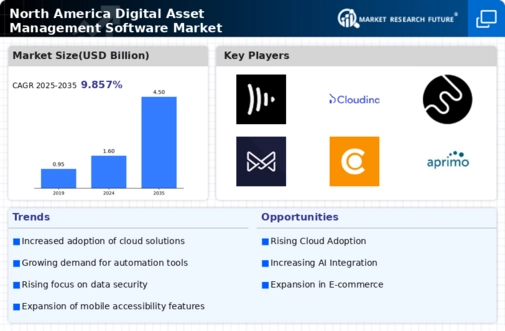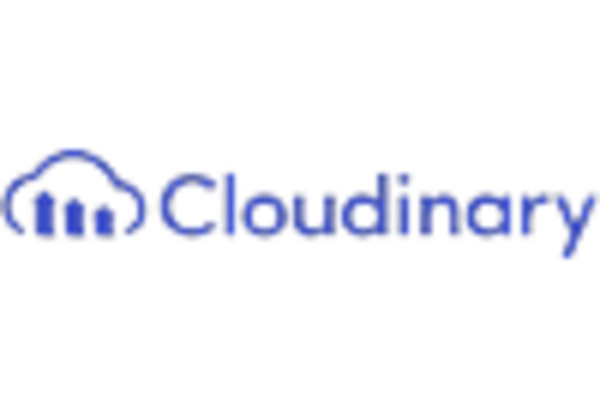Increased Focus on Data Security
Data security has emerged as a critical concern in the digital asset-management-software market in North America. With the rise in cyber threats and data breaches, organizations are prioritizing the protection of their digital assets. This heightened focus on security is prompting businesses to invest in advanced digital asset-management solutions that offer robust security features, such as encryption and access controls. The market is expected to grow significantly, with projections indicating a potential increase of 20% in demand for secure digital asset-management software. As companies seek to safeguard their intellectual property and sensitive information, the emphasis on security will likely shape the future landscape of the digital asset-management software market.
Adoption of Remote Work Practices
The digital asset management software market in North America is being influenced by the widespread adoption of remote work practices. As organizations transition to hybrid work models, the need for accessible and collaborative digital asset-management solutions has become paramount. Companies are increasingly seeking software that allows teams to access, share, and manage digital assets from various locations. This shift is likely to drive market growth, with estimates suggesting a compound annual growth rate of around 12% over the next few years. The ability to manage assets remotely not only enhances productivity but also supports the evolving work culture, making digital asset-management software an essential tool for modern businesses.
Growing Emphasis on Brand Consistency
In the digital asset-management-software market in North America, there is an increasing emphasis on maintaining brand consistency across various channels. Companies are recognizing that a cohesive brand image is crucial for customer loyalty and market positioning. As a result, organizations are investing in digital asset-management solutions that facilitate the uniform distribution of branding materials. This trend is particularly relevant in industries such as retail and media, where brand identity plays a pivotal role. The market is projected to reach $3 billion by 2026, driven by the need for tools that ensure all digital assets align with brand guidelines. Consequently, the demand for sophisticated digital asset-management software is expected to grow as businesses strive to enhance their brand presence.
Integration with Emerging Technologies
The digital asset management software market in North America is witnessing a trend towards integration with emerging technologies, such as machine learning and blockchain. These technologies offer innovative solutions that enhance the functionality and efficiency of digital asset management. For instance, machine learning algorithms can automate asset tagging and categorization, while blockchain technology can provide secure and transparent asset tracking. This integration is expected to drive market growth, with estimates suggesting a potential increase in market size by 18% over the next five years. As organizations seek to leverage these technologies to optimize their digital asset management processes, the demand for advanced software solutions is likely to rise.
Rising Need for Efficient Content Management
The digital asset management software market in North America is experiencing a notable surge in demand due to the increasing need for efficient content management solutions. Organizations are inundated with vast amounts of digital content, necessitating robust systems to organize, store, and retrieve assets effectively. This trend is underscored by a projected growth rate of approximately 15% annually, as companies seek to streamline their workflows and enhance productivity. The ability to manage digital assets efficiently not only reduces operational costs but also improves collaboration among teams. As businesses recognize the value of centralized asset management, investments in digital asset-management software are likely to rise, further propelling the market forward.
















Leave a Comment